Master in Public Health: Health Impact Assessment on Food Insecurity
VerifiedAdded on 2023/06/04
|6
|1474
|362
Report
AI Summary
This report presents a health impact assessment focusing on food insecurity among students at Wollongong University. It begins with an overview of the issue, highlighting the vulnerability of students due to financial stress and its impact on academic performance. The assessment identifies key predictors of food insecurity, such as financial constraints, food prices, cultural diversity, and transportation challenges. To address these issues, the report evaluates strategies like establishing university committees, constructing food canteens, and implementing food aid programs. The assessment includes screening, scoping, appraisal, reporting, and monitoring phases. Furthermore, an advocacy plan is outlined, targeting the university students and stakeholders, with the goal of increasing access to affordable, nutritious food. The report concludes with an analysis of the potential health impacts, risks, and advocacy tools, emphasizing the need for further research and government support to combat food insecurity effectively.
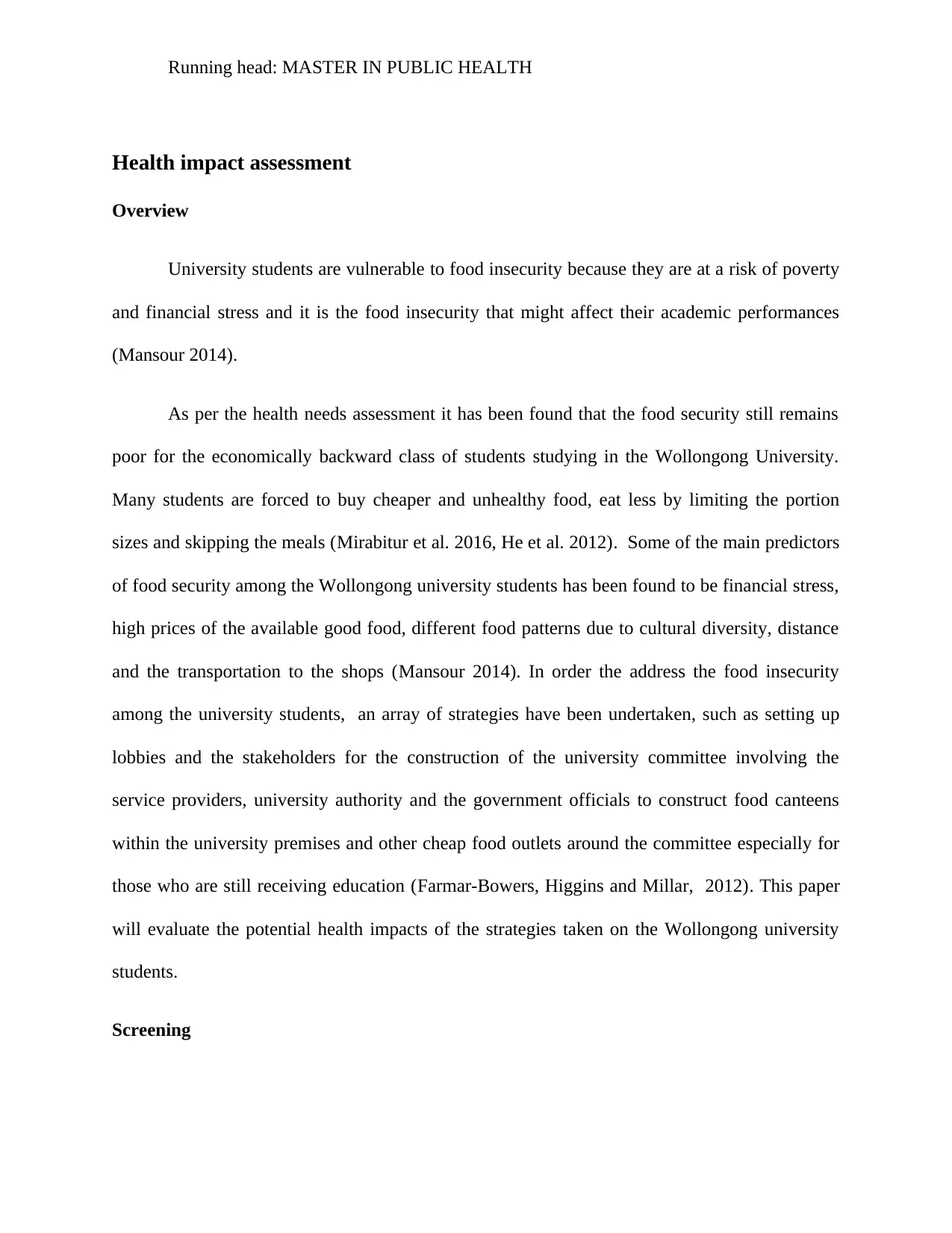
Running head: MASTER IN PUBLIC HEALTH
Health impact assessment
Overview
University students are vulnerable to food insecurity because they are at a risk of poverty
and financial stress and it is the food insecurity that might affect their academic performances
(Mansour 2014).
As per the health needs assessment it has been found that the food security still remains
poor for the economically backward class of students studying in the Wollongong University.
Many students are forced to buy cheaper and unhealthy food, eat less by limiting the portion
sizes and skipping the meals (Mirabitur et al. 2016, He et al. 2012). Some of the main predictors
of food security among the Wollongong university students has been found to be financial stress,
high prices of the available good food, different food patterns due to cultural diversity, distance
and the transportation to the shops (Mansour 2014). In order the address the food insecurity
among the university students, an array of strategies have been undertaken, such as setting up
lobbies and the stakeholders for the construction of the university committee involving the
service providers, university authority and the government officials to construct food canteens
within the university premises and other cheap food outlets around the committee especially for
those who are still receiving education (Farmar-Bowers, Higgins and Millar, 2012). This paper
will evaluate the potential health impacts of the strategies taken on the Wollongong university
students.
Screening
Health impact assessment
Overview
University students are vulnerable to food insecurity because they are at a risk of poverty
and financial stress and it is the food insecurity that might affect their academic performances
(Mansour 2014).
As per the health needs assessment it has been found that the food security still remains
poor for the economically backward class of students studying in the Wollongong University.
Many students are forced to buy cheaper and unhealthy food, eat less by limiting the portion
sizes and skipping the meals (Mirabitur et al. 2016, He et al. 2012). Some of the main predictors
of food security among the Wollongong university students has been found to be financial stress,
high prices of the available good food, different food patterns due to cultural diversity, distance
and the transportation to the shops (Mansour 2014). In order the address the food insecurity
among the university students, an array of strategies have been undertaken, such as setting up
lobbies and the stakeholders for the construction of the university committee involving the
service providers, university authority and the government officials to construct food canteens
within the university premises and other cheap food outlets around the committee especially for
those who are still receiving education (Farmar-Bowers, Higgins and Millar, 2012). This paper
will evaluate the potential health impacts of the strategies taken on the Wollongong university
students.
Screening
Paraphrase This Document
Need a fresh take? Get an instant paraphrase of this document with our AI Paraphraser
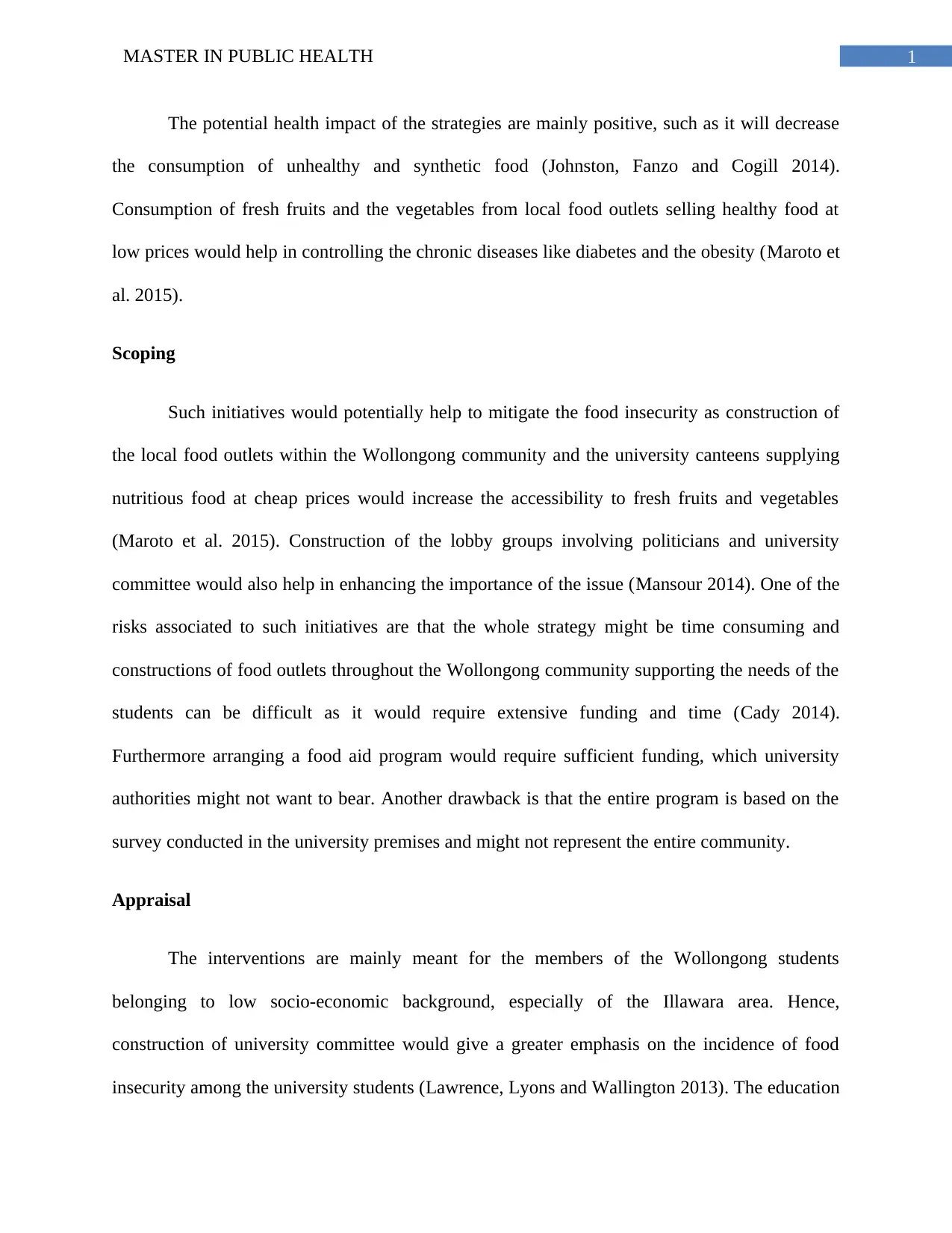
1MASTER IN PUBLIC HEALTH
The potential health impact of the strategies are mainly positive, such as it will decrease
the consumption of unhealthy and synthetic food (Johnston, Fanzo and Cogill 2014).
Consumption of fresh fruits and the vegetables from local food outlets selling healthy food at
low prices would help in controlling the chronic diseases like diabetes and the obesity (Maroto et
al. 2015).
Scoping
Such initiatives would potentially help to mitigate the food insecurity as construction of
the local food outlets within the Wollongong community and the university canteens supplying
nutritious food at cheap prices would increase the accessibility to fresh fruits and vegetables
(Maroto et al. 2015). Construction of the lobby groups involving politicians and university
committee would also help in enhancing the importance of the issue (Mansour 2014). One of the
risks associated to such initiatives are that the whole strategy might be time consuming and
constructions of food outlets throughout the Wollongong community supporting the needs of the
students can be difficult as it would require extensive funding and time (Cady 2014).
Furthermore arranging a food aid program would require sufficient funding, which university
authorities might not want to bear. Another drawback is that the entire program is based on the
survey conducted in the university premises and might not represent the entire community.
Appraisal
The interventions are mainly meant for the members of the Wollongong students
belonging to low socio-economic background, especially of the Illawara area. Hence,
construction of university committee would give a greater emphasis on the incidence of food
insecurity among the university students (Lawrence, Lyons and Wallington 2013). The education
The potential health impact of the strategies are mainly positive, such as it will decrease
the consumption of unhealthy and synthetic food (Johnston, Fanzo and Cogill 2014).
Consumption of fresh fruits and the vegetables from local food outlets selling healthy food at
low prices would help in controlling the chronic diseases like diabetes and the obesity (Maroto et
al. 2015).
Scoping
Such initiatives would potentially help to mitigate the food insecurity as construction of
the local food outlets within the Wollongong community and the university canteens supplying
nutritious food at cheap prices would increase the accessibility to fresh fruits and vegetables
(Maroto et al. 2015). Construction of the lobby groups involving politicians and university
committee would also help in enhancing the importance of the issue (Mansour 2014). One of the
risks associated to such initiatives are that the whole strategy might be time consuming and
constructions of food outlets throughout the Wollongong community supporting the needs of the
students can be difficult as it would require extensive funding and time (Cady 2014).
Furthermore arranging a food aid program would require sufficient funding, which university
authorities might not want to bear. Another drawback is that the entire program is based on the
survey conducted in the university premises and might not represent the entire community.
Appraisal
The interventions are mainly meant for the members of the Wollongong students
belonging to low socio-economic background, especially of the Illawara area. Hence,
construction of university committee would give a greater emphasis on the incidence of food
insecurity among the university students (Lawrence, Lyons and Wallington 2013). The education
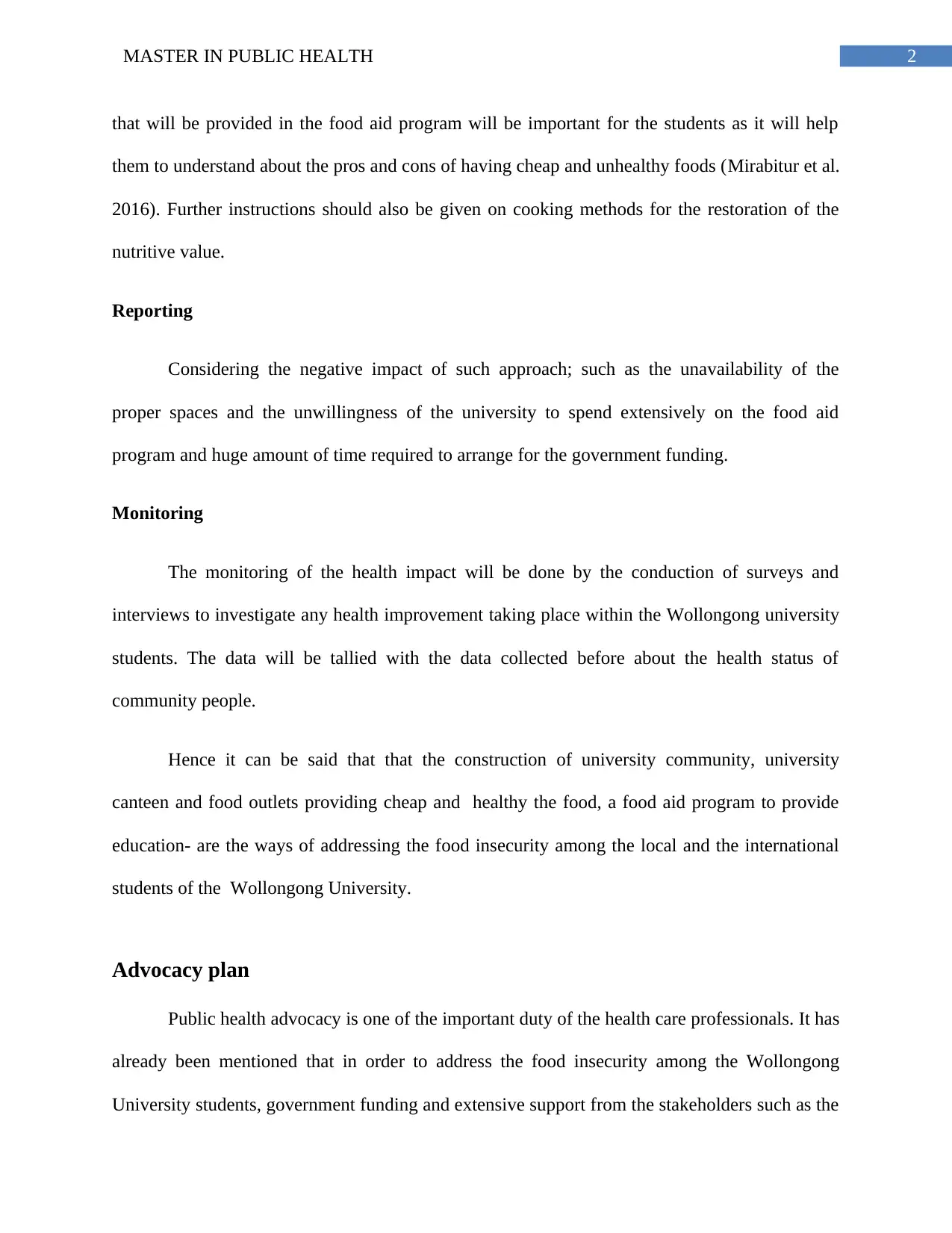
2MASTER IN PUBLIC HEALTH
that will be provided in the food aid program will be important for the students as it will help
them to understand about the pros and cons of having cheap and unhealthy foods (Mirabitur et al.
2016). Further instructions should also be given on cooking methods for the restoration of the
nutritive value.
Reporting
Considering the negative impact of such approach; such as the unavailability of the
proper spaces and the unwillingness of the university to spend extensively on the food aid
program and huge amount of time required to arrange for the government funding.
Monitoring
The monitoring of the health impact will be done by the conduction of surveys and
interviews to investigate any health improvement taking place within the Wollongong university
students. The data will be tallied with the data collected before about the health status of
community people.
Hence it can be said that that the construction of university community, university
canteen and food outlets providing cheap and healthy the food, a food aid program to provide
education- are the ways of addressing the food insecurity among the local and the international
students of the Wollongong University.
Advocacy plan
Public health advocacy is one of the important duty of the health care professionals. It has
already been mentioned that in order to address the food insecurity among the Wollongong
University students, government funding and extensive support from the stakeholders such as the
that will be provided in the food aid program will be important for the students as it will help
them to understand about the pros and cons of having cheap and unhealthy foods (Mirabitur et al.
2016). Further instructions should also be given on cooking methods for the restoration of the
nutritive value.
Reporting
Considering the negative impact of such approach; such as the unavailability of the
proper spaces and the unwillingness of the university to spend extensively on the food aid
program and huge amount of time required to arrange for the government funding.
Monitoring
The monitoring of the health impact will be done by the conduction of surveys and
interviews to investigate any health improvement taking place within the Wollongong university
students. The data will be tallied with the data collected before about the health status of
community people.
Hence it can be said that that the construction of university community, university
canteen and food outlets providing cheap and healthy the food, a food aid program to provide
education- are the ways of addressing the food insecurity among the local and the international
students of the Wollongong University.
Advocacy plan
Public health advocacy is one of the important duty of the health care professionals. It has
already been mentioned that in order to address the food insecurity among the Wollongong
University students, government funding and extensive support from the stakeholders such as the
⊘ This is a preview!⊘
Do you want full access?
Subscribe today to unlock all pages.

Trusted by 1+ million students worldwide
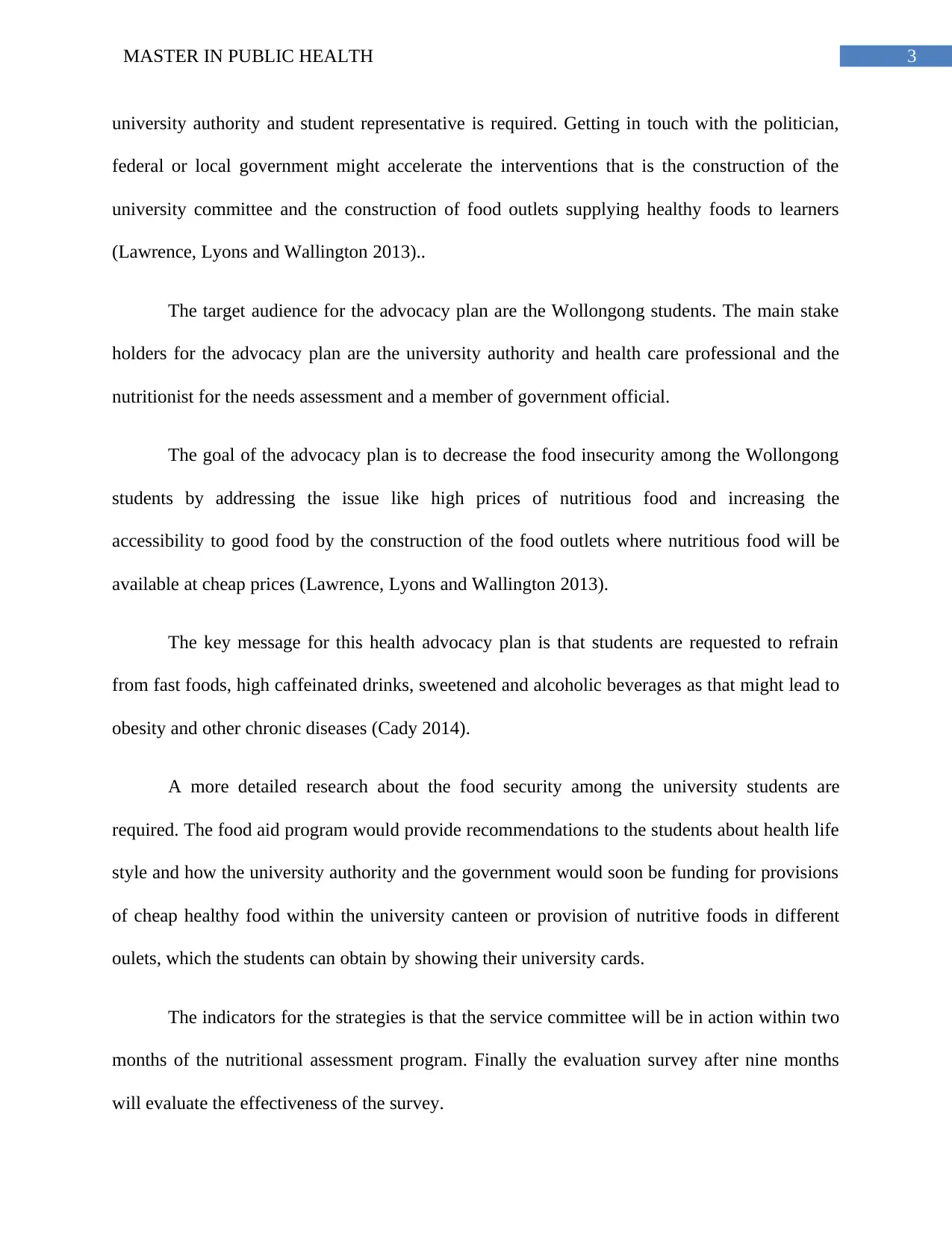
3MASTER IN PUBLIC HEALTH
university authority and student representative is required. Getting in touch with the politician,
federal or local government might accelerate the interventions that is the construction of the
university committee and the construction of food outlets supplying healthy foods to learners
(Lawrence, Lyons and Wallington 2013)..
The target audience for the advocacy plan are the Wollongong students. The main stake
holders for the advocacy plan are the university authority and health care professional and the
nutritionist for the needs assessment and a member of government official.
The goal of the advocacy plan is to decrease the food insecurity among the Wollongong
students by addressing the issue like high prices of nutritious food and increasing the
accessibility to good food by the construction of the food outlets where nutritious food will be
available at cheap prices (Lawrence, Lyons and Wallington 2013).
The key message for this health advocacy plan is that students are requested to refrain
from fast foods, high caffeinated drinks, sweetened and alcoholic beverages as that might lead to
obesity and other chronic diseases (Cady 2014).
A more detailed research about the food security among the university students are
required. The food aid program would provide recommendations to the students about health life
style and how the university authority and the government would soon be funding for provisions
of cheap healthy food within the university canteen or provision of nutritive foods in different
oulets, which the students can obtain by showing their university cards.
The indicators for the strategies is that the service committee will be in action within two
months of the nutritional assessment program. Finally the evaluation survey after nine months
will evaluate the effectiveness of the survey.
university authority and student representative is required. Getting in touch with the politician,
federal or local government might accelerate the interventions that is the construction of the
university committee and the construction of food outlets supplying healthy foods to learners
(Lawrence, Lyons and Wallington 2013)..
The target audience for the advocacy plan are the Wollongong students. The main stake
holders for the advocacy plan are the university authority and health care professional and the
nutritionist for the needs assessment and a member of government official.
The goal of the advocacy plan is to decrease the food insecurity among the Wollongong
students by addressing the issue like high prices of nutritious food and increasing the
accessibility to good food by the construction of the food outlets where nutritious food will be
available at cheap prices (Lawrence, Lyons and Wallington 2013).
The key message for this health advocacy plan is that students are requested to refrain
from fast foods, high caffeinated drinks, sweetened and alcoholic beverages as that might lead to
obesity and other chronic diseases (Cady 2014).
A more detailed research about the food security among the university students are
required. The food aid program would provide recommendations to the students about health life
style and how the university authority and the government would soon be funding for provisions
of cheap healthy food within the university canteen or provision of nutritive foods in different
oulets, which the students can obtain by showing their university cards.
The indicators for the strategies is that the service committee will be in action within two
months of the nutritional assessment program. Finally the evaluation survey after nine months
will evaluate the effectiveness of the survey.
Paraphrase This Document
Need a fresh take? Get an instant paraphrase of this document with our AI Paraphraser
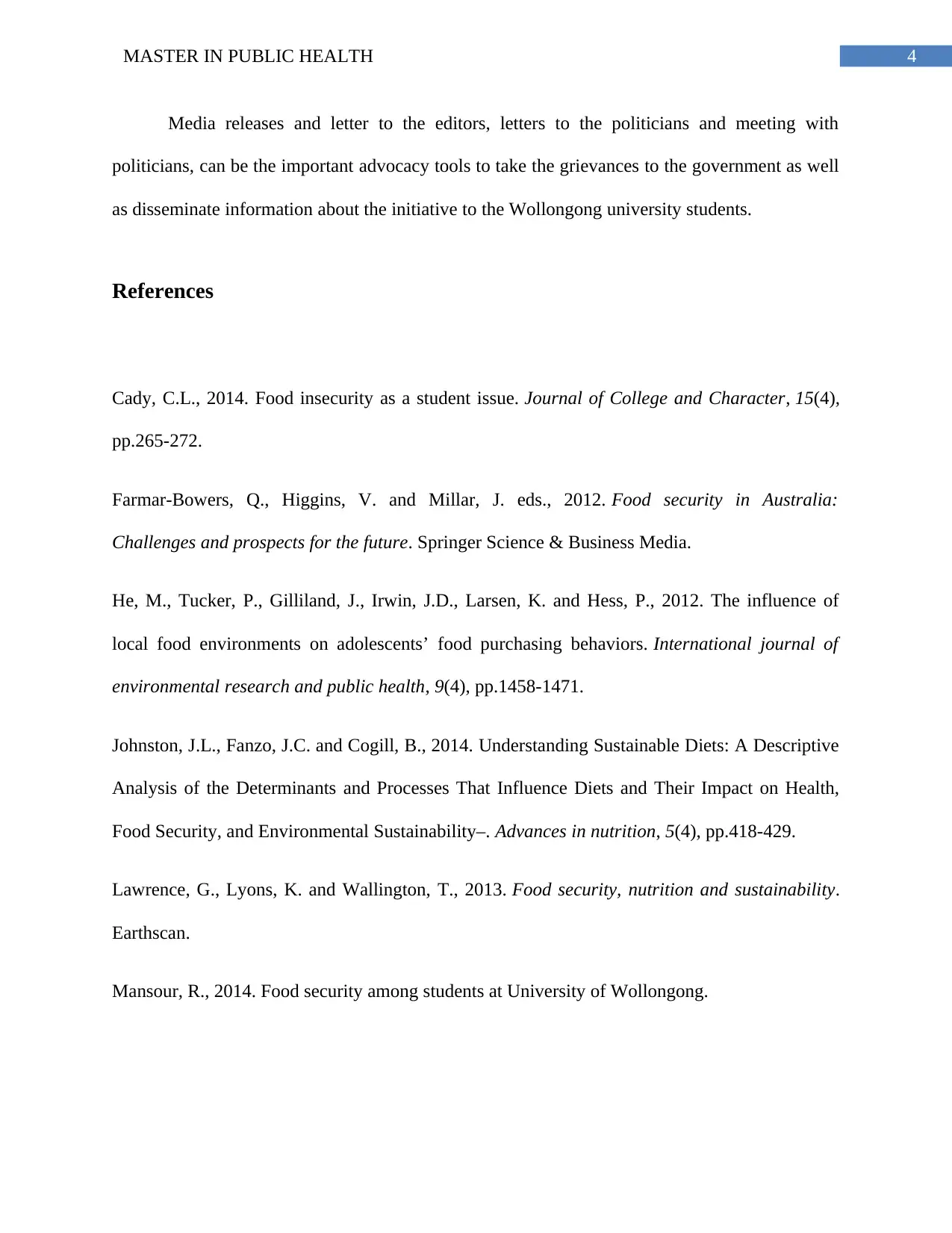
4MASTER IN PUBLIC HEALTH
Media releases and letter to the editors, letters to the politicians and meeting with
politicians, can be the important advocacy tools to take the grievances to the government as well
as disseminate information about the initiative to the Wollongong university students.
References
Cady, C.L., 2014. Food insecurity as a student issue. Journal of College and Character, 15(4),
pp.265-272.
Farmar-Bowers, Q., Higgins, V. and Millar, J. eds., 2012. Food security in Australia:
Challenges and prospects for the future. Springer Science & Business Media.
He, M., Tucker, P., Gilliland, J., Irwin, J.D., Larsen, K. and Hess, P., 2012. The influence of
local food environments on adolescents’ food purchasing behaviors. International journal of
environmental research and public health, 9(4), pp.1458-1471.
Johnston, J.L., Fanzo, J.C. and Cogill, B., 2014. Understanding Sustainable Diets: A Descriptive
Analysis of the Determinants and Processes That Influence Diets and Their Impact on Health,
Food Security, and Environmental Sustainability–. Advances in nutrition, 5(4), pp.418-429.
Lawrence, G., Lyons, K. and Wallington, T., 2013. Food security, nutrition and sustainability.
Earthscan.
Mansour, R., 2014. Food security among students at University of Wollongong.
Media releases and letter to the editors, letters to the politicians and meeting with
politicians, can be the important advocacy tools to take the grievances to the government as well
as disseminate information about the initiative to the Wollongong university students.
References
Cady, C.L., 2014. Food insecurity as a student issue. Journal of College and Character, 15(4),
pp.265-272.
Farmar-Bowers, Q., Higgins, V. and Millar, J. eds., 2012. Food security in Australia:
Challenges and prospects for the future. Springer Science & Business Media.
He, M., Tucker, P., Gilliland, J., Irwin, J.D., Larsen, K. and Hess, P., 2012. The influence of
local food environments on adolescents’ food purchasing behaviors. International journal of
environmental research and public health, 9(4), pp.1458-1471.
Johnston, J.L., Fanzo, J.C. and Cogill, B., 2014. Understanding Sustainable Diets: A Descriptive
Analysis of the Determinants and Processes That Influence Diets and Their Impact on Health,
Food Security, and Environmental Sustainability–. Advances in nutrition, 5(4), pp.418-429.
Lawrence, G., Lyons, K. and Wallington, T., 2013. Food security, nutrition and sustainability.
Earthscan.
Mansour, R., 2014. Food security among students at University of Wollongong.
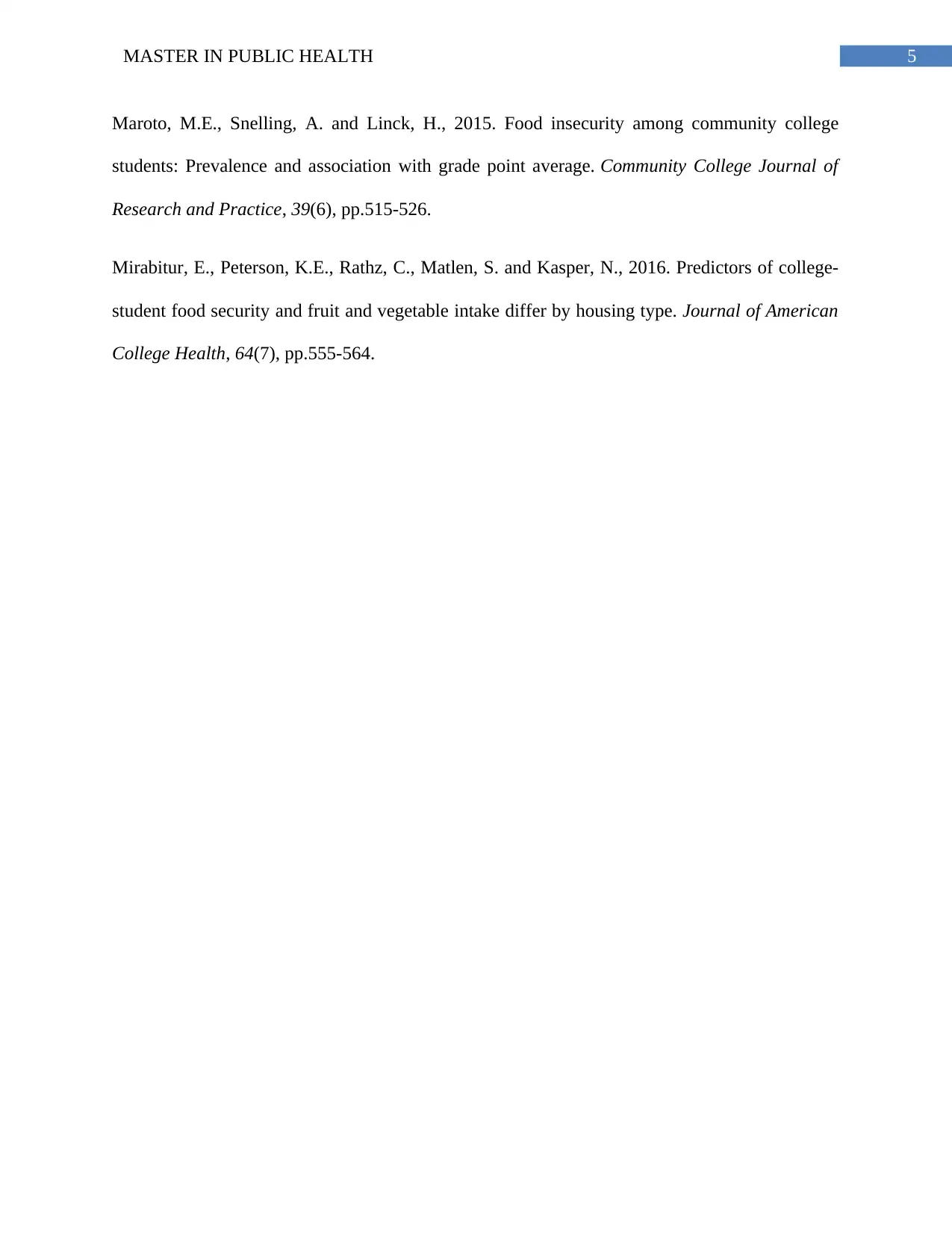
5MASTER IN PUBLIC HEALTH
Maroto, M.E., Snelling, A. and Linck, H., 2015. Food insecurity among community college
students: Prevalence and association with grade point average. Community College Journal of
Research and Practice, 39(6), pp.515-526.
Mirabitur, E., Peterson, K.E., Rathz, C., Matlen, S. and Kasper, N., 2016. Predictors of college-
student food security and fruit and vegetable intake differ by housing type. Journal of American
College Health, 64(7), pp.555-564.
Maroto, M.E., Snelling, A. and Linck, H., 2015. Food insecurity among community college
students: Prevalence and association with grade point average. Community College Journal of
Research and Practice, 39(6), pp.515-526.
Mirabitur, E., Peterson, K.E., Rathz, C., Matlen, S. and Kasper, N., 2016. Predictors of college-
student food security and fruit and vegetable intake differ by housing type. Journal of American
College Health, 64(7), pp.555-564.
⊘ This is a preview!⊘
Do you want full access?
Subscribe today to unlock all pages.

Trusted by 1+ million students worldwide
1 out of 6
Related Documents
Your All-in-One AI-Powered Toolkit for Academic Success.
+13062052269
info@desklib.com
Available 24*7 on WhatsApp / Email
![[object Object]](/_next/static/media/star-bottom.7253800d.svg)
Unlock your academic potential
Copyright © 2020–2025 A2Z Services. All Rights Reserved. Developed and managed by ZUCOL.



